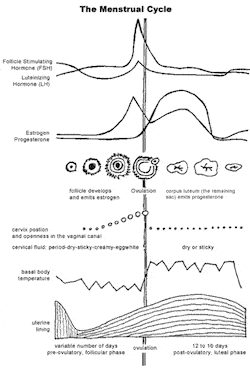Natural birth control can help you avoid pregnancy naturally, using only non-hormonal methods. Learn about the effectiveness of natural family planning, and about alternative birth control options.
Did you know that you can only get pregnant five days out of the month? The options for contraception in conventional medicine are limited to IUDs, the Pill, the Patch, the shot, condoms, or getting your tubes tied. Family Planning, or the Fertility Awareness Method, has been preserved mostly by Catholic Practices for pregnancy prevention and/or planning. And when done correctly, it is just as effective; if not more effective, than the options listed above, and without any side effects other than knowing your body better!
The fertility awareness method (FAM) differs from more popular period-predictor app tracking. With FAM, you track your cycle daily, whereas, with period predictor apps, only your period is truly predictable. I like to compare them using a weather app analogy. Period predictor apps are like checking your app for the weather whereas FAM tracking is similar to stepping outside to check the weather. Stepping outside, or FAM, is obviously much more accurate. We don’t all ovulate mid-cycle, so predicting ovulation based on period prediction can lead to unplanned pregnancies and confusion. Using FAM is the best non-hormonal form of contraception.
How do you begin FAM now?
There are many ways to use FAM. One is an app, the other is recording. The book, Garden of Fertility, is one of the best short-form training methods that I know. I often recommend the Read Your Body App to begin, paired with the Temp Drop monitor. **Discount Codes applied
There is a four-legged stool to use while beginning to use FAM as a method of getting pregnant or avoiding pregnancy:
- Basal Body Temperature, or waking body temperature (Temp Drop)
- Cervical Mucus
- Cervical Position
- (LH Strips // OPKs // Ovulation Predictor Kits)
Your Basal Body Temperature (BBT), or waking temperature, can be measured with an oral BBT-specific thermometer or Temp Drop Sensor. I find that using Temp Drop allows for more accurate results and/or reduces user error. It syncs directly with Read Your Body for ease of use. The idea of using BBT is that your temperature is lower during the first half of your cycle (your follicular phase) and higher the day after ovulation, or the second half of your cycle (your Luteal Phase). Generally, in a healthy cycling female, your BBT rises by an entire degree. By measuring your BBT daily, you will be the first one to know if you’re pregnant and you’ll be able to date precisely. Dating pregnancies and development is often off +/- 2 weeks, which makes a huge difference when calculating fetal development and delivery dates. If you are pregnant, your BBT simply continues to climb up when you should be expecting your period. The day we begin to bleed (day 1 of your cycle), your temperature drops and the follicular phase begins.
The image below is a visual illustration of what is happening with your brain hormones communicating with your ovarian hormones and the physical signs of tracking your cycle: The egg and follicle, cervical position, cervical mucous, waking body temperature (BBT), and uterine lining.

Often you can identify thyroid regulation issues, how food and sleep affect your temperature, luteal phase defects (progesterone issues) and metabolism, and other health interferences using BBT and working with your FAM specialist or Doctor who knows FAM.
Cervical Mucus is something we are not used to tracking and usually, you only notice it in the middle of sex, or when you ovulate. After bleeding, usually, you have non-peak (not as egg white-like) mucus to the feeling of no mucus. Non-peak mucus does not string out like egg white does when you use the finger stick check. At times, in clinic, I hear about mid-cycle spotting or bleeding during ovulation. This can be abnormal and indicate an infection, or it can be totally normal.
Peak mucus is egg white, sticks between your fingers, and is stringy. Non-peak mucus is tacky and does not string out.
There is also a sensation to note while you are tracking cervical mucus. Often throughout your cycle, after you pee and go to wipe, you can feel that it is slick. This is a great indication to check for your mucus. If it is egg white, you have ovulated, and can expect your temperature to rise the next day. If it is non-peak, you feel it tacky, and you are either revving up for ovulation, or have already ovulated. This is why you use temperature and cervical position to confirm, with the extra backup of ovulation predictor kits.
When should I use OPKs/ LH Strips?
OPKs work for about thirty to forty percent of women I see in office. I like to use them as a confirmation rather than confirming ovulation with these alone. I do not recommend them for women with PCOS or irregular cycles, though when in combination with FAM, it can be helpful information.
Cervical Position is the oddest sign to check for when you are tracking using FAM. You need to use two fingers and insert them high into your vagina to check and see if you feel your cervix. Most of us don’t feel organs on a daily basis, so this can be very confusing. If you feel your cervix with your fingers, it may be painful, numb, or pleasurable. When you are not ovulating, your cervix is lower and more firm. And when you are ovulating your cervix is higher (often not feelable) and softer. If your cervix is firm and lower, it will feel like the texture of the tip of your nose. If your cervix is higher and softer, it will feel like the texture of your cheek. Most women cannot reach their cervix or feel it when they are ovulating. So basically the way to check your position is to practice. Feel for it daily, take note, trust yourself and you will notice a pattern. This is the art of medicine, observing. This is the practice of body literacy, learning to trust your observation and your experience in your body. Without body literacy, we have no sovereignty.
I love the chart in this article by Garden of Fertility as a summary of what is happening in your body.
The first half of your cycle, the Follicular phase is from menses to ovulation.
- You can expect your cervix to be lower and firmer (nose tip texture) and to raise and soften as you approach ovulation.
- Your mucus will become more abundant as you approach ovulation.
- Your BBT/ waking body temperature will go from lower and raise after ovulation
The second half your cycle, the Luteal Phase, is from ovulation to menses:
- Your cervix will lower and become firmer.
- Your mucus will begin to lessen and become non-peak to dry
- Your waking body temperature / BBT will rise significantly (about one degree)
Is FAM right for you?
Fam does not work the same if you are on contraception. But if you are planning to get off birth control, it is great to begin tracking the month before as you prepare to get off of birth control in order to hone your tracking skills and notice how it shifts when you stop using medical contraception. You need to wait at least three months as your cycle normalizes in order to use FAM confidently as a contraceptive method. In the meantime, I suggest using SKIN condoms, which are okay with any lubricant.
FAM is extremely useful if you are in perimenopause, although using it as pregnancy prevention can be tricky at times. As you approach perimenopause you can ovulate multiple times in a cycle. Some sort of sick joke, in my opinion, for the ladies that are absolutely done with family planning. And the uterus’ last hurrah for carrying a baby 🙂 If you happen to be trying to conceive during this phase of your life, I suggest having a thorough hormone workup, including the labs in my lab handout for fertility to ensure your progesterone and estrogen levels are healthy, as well as DHEA-S, testosterone, LH/FSH, and thyroid. In my courses, or lab review appointments you receive a handout for optimal lab values and videos. This gives medical sovereignty for life, teaches you how to fish, or how to advocate.
FAM can be hard to use when your cycles are irregular, yet it’s a great indicator to understand the root cause of your hormone imbalances alongside the help of your health care provider or FAM specialist.
If you are not into tracking, or body literacy, don’t use FAM. It is not a great form of contraception if you have erratic schedules and inconsistent tracking. I suggest beginning to practice FAM with condoms until you begin to trust yourself to monitor. I recommend using FAM for at least three months before using it as your sole form of contraception.
FAM and Cyclical Living
FAM is an awesome method if you are looking to incorporate Cyclical Living into your wellness plan. Cyclical Living allows you to begin to “biohack your schedule around your hormone cycle.” This helps with training, work, meetings, and extracurricular to help you truly feel like superwoman and allow periods of rest that are more in sync with your hormones. Most women that join my Cyclical Living courses never stop using the method, or they revisit it at a time of fatigue as their number one tool. You can read more about Cyclical Living here.
Pregnancy / Pregnancy Prevention Advise using FAM
Remember, there are only five days out of the month that you can get pregnant? Cervical mucus can act as a “slip n slide” for sperm. It makes your vagina hospitable to sperm. Otherwise, your vaginal pH is like the D-day beach war zone killing sperm upon entry. Sperm can live in your vagina and uterus for five days during your fertile time, being most fertile just before and on ovulation. Your egg only exists in your fallopian tubes for 24 hours. So if your egg is hanging out, waiting to meet her next propositioners, then you can become pregnant within 1-2 weeks (after implantation).
If you are trying to conceive, allowing the sperm to become more concentrated by having sex every other day leading up to ovulation is a great method. If you are trying to avoid pregnancy, I recommend using condoms during this time. Truly, using caution a week before ovulation is best to avoid any unplanned pregnancies.
The pull-out method is great if your partner has astute body awareness. Remember, precum is concentrated sperm, so using the pull-out method around your fertile period is not pregnancy-proofed.
Some women ovulate during their periods. You can only truly figure this out by using the cup or period panties and seeing the mucus mixed in your blood.
Otherwise, I recommend using pull-out during your period, after ovulation (once you are very familiar with FAM), and using additional caution, otherwise, such as condoms.
Side effects of synthetic hormones – Post-Birth Control Syndrome
The Pill is still the most commonly offered contraception for clients that I see in office that have been trying to manage their period symptoms. There are many different variations of the Pill. This includes an Estrogen/ Progestin combination and the progestin-only.
A common question that I receive is “How is Progestin different from the anti-inflammatory hormone Progesterone?” It is totally different. Progestin and Estrogen doses in birth control pills do not work in conjunction with your brain hormones from your pituitary and hypothalamus that are responsible for communicating to your ovaries. In fact, they shut down that cycle and tell your Pituitary gland to stop producing LH and FSH (the follicle-stimulating hormone). So you stop ovulating.
The Pill will never fix your hormones. As you tell your ovaries to shut down their jobs, it may be a short solution to your symptoms, but after being shut down, your hormones rage with a vengeance. Because you have shut down essential communication for a period of time, you get major rebound symptoms when you decide to come off of hormonal contraception. This is known as Post-Birth Control Syndrome; and unfortunately, it gets far too little attention in the world of women’s health.
The truth is that if you throw a wrench into your hormonal cycle, it will not go well at all for you in the long term. Hormonal contraception is great if you are avoiding pregnancy. If you choose to take contraceptives to avoid pregnancy, this can be a great idea. But be sure to talk with your doctor about which nutrients your medication can deplete so that you can supplement. You may want to consider taking a B-complex (possibly methylated Bs), eating plenty of cruciferous vegetables to help you detoxify, and Magnesium bisglycinate while you are on contraceptives.
Synthetic hormones can wreak havoc on your body. It is common for Doctors to give you the Pill without one word about side effects. Well, here they are. B vitamins are essential for your mood. That’s because the most common side effect I see with women on birth control is anxiousness and depression. Many women are able to increase their capacity for managing stress with my Somatic Experiencing Therapy as an integral part of their treatment plans.
The Birth control pill also depletes essential minerals for Thyroid function. Thyroid function can be decreased for years after taking the Pill. Furthermore, the Pill increases sex hormone-binding globulin, which binds to your hormones and makes them inactive. Hypothyroidism is one of the most common causes of recurrent miscarriages and infertility. It is also a common cause of unexplained weight gain, fatigue, and losing hair.
Digestive health problems are one of the other most common birth Control Pill side effects experienced by women with Post-Birth Control Syndrome. Anemia, mood irregularities, tanked sex-drive, low energy, low motivation, and anxiety are also common side effects.
The Pill interferes with your brain’s communication to your ovaries (the hypothalamus and pituitary hormones), which are responsible for hormone production. When no LH is released from your pituitary, you never ovulate. And you never produce the anti-inflammatory hormone progesterone. LH transforms cells in the ovary that makes estrogen into a cluster of cells that make progesterone. So if you shut off LH’s communication with your ovaries, you essentially shut down the production of Estrogen and Progesterone. This is the ultimate hormone disruptor. If you are curious about birth control and perimenopause, read more about Celia’s Perimenopause Journey: A Personal Story Beyond Birth Control.
I was told to take Birth Control. What should I do next?
If you are on the Birth Control Pill or other forms of hormonal contraception and experiencing side effects, discuss your options with your integrated Doctor. In order to avoid Post-Birth Control Syndrome, you will need to strategically discontinue your medication. This can include detoxification of the hormones you had in your body, nutrient supplementation, and careful monitoring of thyroid hormone.
Don’t get me wrong. I believe birth control is great to prevent pregnancy. But it is not indicated to act as a hormone regulator. If you are looking for solutions for cramps, irregular periods, acne, PCOS, endometriosis, or more hormone issues please contact me for a visit, or see one of my group courses. My PCOS group and Birth Control group courses have set many women up for success teaching FAM, individualized medicine, labs, and total health. To discover how you can begin your personalised hormone healing journey, click here to schedule an initial visit.
In Summary
Knowing your options for contraceptives is extremely important. FAM is essential for body awareness, Cyclical Living, and family planning. The three-legged stool for FAM is basal body temperature (using temp drop or an oral BBT thermometer), cervical mucus, and cervical position. Learning to track your cycle daily is the first step to beginning Cyclical Living and becoming more body-literate. If you are wanting to befriend your body, learn about your hormones and energy levels from a deeper perspective, and want to become empowered with your options, then FAM is a great method. Hormonal contraceptives do not come without side effects and the side effects can range from minor to severe. If you are using hormonal contraceptives, ensure that you take the correct nutrients to mitigate the side effects. And you can still use Cyclical Living if you are taking birth control as a medication. In today’s political climate, reproductive health justice is essential, and understanding FAM takes you one step closer to medical sovereignty.



